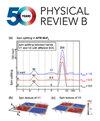Bipartite mutual information in classical many-body dynamics
IF 3.7
2区 物理与天体物理
Q1 Physics and Astronomy
引用次数: 0
Abstract
Information theoretic measures have helped to sharpen our understanding of many-body quantum states. As perhaps the most well-known example, the entanglement entropy (or more generally, the bipartite mutual information) has become a powerful tool for characterizing the dynamical growth of quantum correlations. By contrast, although computable, the bipartite mutual information (MI) is almost never explored in classical many particle systems; this owes in part to the fact that computing the MI requires keeping track of the evolution of the full probability distribution, a feat which is rarely done (or thought to be needed) in classical many-body simulations. Here, we utilize the MI to analyze the spreading of information in 1D elementary cellular automata (CA). Broadly speaking, we find that the behavior of the MI in these dynamical systems exhibits a few different types of scaling that roughly correspond to known CA universality classes. Of particular note is that we observe a set of automata for which the MI converges parametrically slowly to its thermodynamic value. We develop a microscopic understanding of this behavior by analyzing a two-species model of annihilating particles moving in opposite directions. Our work suggests the possibility that information theoretic tools such as the MI might enable a more fine-grained characterization of classical many-body states and dynamics.

经典多体动力学中的二方互信息
信息论测量有助于加深我们对多体量子态的理解。最著名的例子可能是纠缠熵(或更广义的双向互信息),它已成为表征量子相关性动态增长的有力工具。相比之下,尽管双向互信息(MI)是可计算的,但在经典多粒子系统中几乎从未被探索过;部分原因在于计算 MI 需要跟踪完整概率分布的演化,而这在经典多体模拟中很少实现(或被认为需要)。在这里,我们利用 MI 分析一维基本细胞自动机(CA)中的信息传播。概括地说,我们发现 MI 在这些动力学系统中的行为表现出几种不同类型的缩放,大致对应于已知的 CA 普遍性类别。特别值得注意的是,我们观察到一组自动机的 MI 缓慢地收敛到其热力学值。我们通过分析一个反向运动的湮灭粒子的双物种模型,从微观上理解了这种行为。我们的研究表明,MI 等信息论工具有可能对经典多体状态和动力学进行更精细的描述。
本文章由计算机程序翻译,如有差异,请以英文原文为准。
求助全文
约1分钟内获得全文
求助全文
来源期刊

Physical Review B
物理-物理:凝聚态物理
CiteScore
6.70
自引率
32.40%
发文量
0
审稿时长
3.0 months
期刊介绍:
Physical Review B (PRB) is the world’s largest dedicated physics journal, publishing approximately 100 new, high-quality papers each week. The most highly cited journal in condensed matter physics, PRB provides outstanding depth and breadth of coverage, combined with unrivaled context and background for ongoing research by scientists worldwide.
PRB covers the full range of condensed matter, materials physics, and related subfields, including:
-Structure and phase transitions
-Ferroelectrics and multiferroics
-Disordered systems and alloys
-Magnetism
-Superconductivity
-Electronic structure, photonics, and metamaterials
-Semiconductors and mesoscopic systems
-Surfaces, nanoscience, and two-dimensional materials
-Topological states of matter
 求助内容:
求助内容: 应助结果提醒方式:
应助结果提醒方式:


